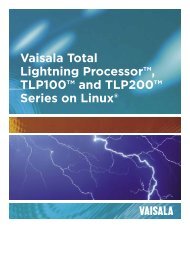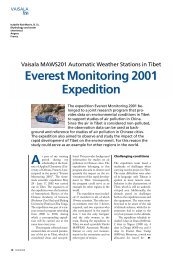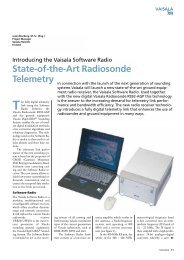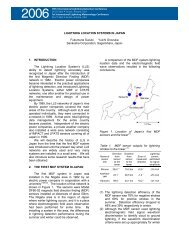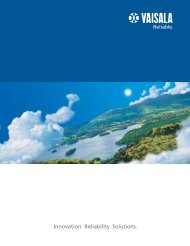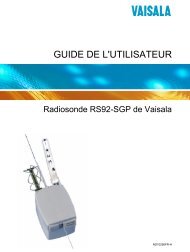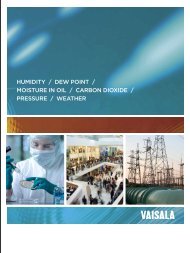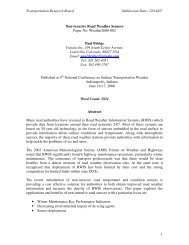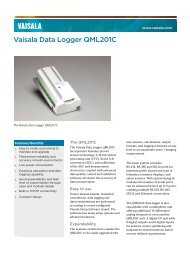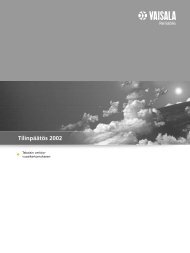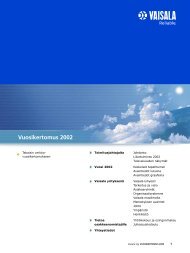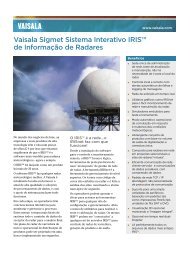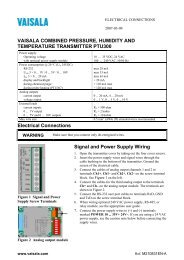GMP Warehouse Mapping (pdf, 1402KB) - Vaisala
GMP Warehouse Mapping (pdf, 1402KB) - Vaisala
GMP Warehouse Mapping (pdf, 1402KB) - Vaisala
You also want an ePaper? Increase the reach of your titles
YUMPU automatically turns print PDFs into web optimized ePapers that Google loves.
<strong>GMP</strong> <strong>Warehouse</strong><br />
<strong>Mapping</strong><br />
/ Step-by-Step GuidelineS for ValidatinG life Science<br />
StoraGe facilitieS
Good manufacturing practice (<strong>GMP</strong>) regulators in the United States,<br />
Canada, European Union, Japan, Australia, and China have sharpened<br />
their focus on warehouse storage and distribution practices. Driving<br />
this trend is a shift in regulatory thinking from quality-by-test to<br />
quality-by-design systems with emphasis on level of risk to product<br />
quality and patient safety. Other drivers include greater demand for<br />
storage facilities due to globalization of manufacturing, increase in<br />
temperature-sensitive biopharmaceuticals, and changes in technology.<br />
Regulators in these countries<br />
require “mapping” the temperature<br />
and relative humidity profile of<br />
warehouses for environmentally<br />
sensitive life science products. This<br />
step-by-step guide describes how to<br />
map a warehouse to comply with<br />
internationally recognized <strong>GMP</strong>s,<br />
including many that have been<br />
published or revised recently. (See<br />
Regulations and Guidance at the<br />
end of this paper for more detailed<br />
2<br />
citations of <strong>GMP</strong>s.) This guide,<br />
intended for use by any organization<br />
involved in the storage and distribution<br />
of products sensitive to temperature<br />
and humidity in a <strong>GMP</strong>-compliant<br />
environment, draws on <strong>Vaisala</strong>’s<br />
extensive customer experience<br />
throughout North America and Europe.<br />
Indeed, <strong>Vaisala</strong>’s environmental and<br />
industrial measuring and monitoring<br />
products are used in more than<br />
140 countries.
Step by Step – Good practice <strong>Warehouse</strong><br />
<strong>Mapping</strong><br />
<strong>Vaisala</strong> recommends a nine-point<br />
process for successful mapping<br />
of a warehouse or other regulated<br />
storage space:<br />
1. Create a validation plan<br />
2. Identify areas at risk<br />
3. Develop protocol information<br />
4. Determine sensor distribution<br />
5. Select suitable technology<br />
6. Set up mapping equipment<br />
7. Conduct test and review data<br />
8. Make modifications<br />
9. Document and schedule<br />
mapping tests<br />
These nine steps will help you<br />
design and execute a successful<br />
mapping plan. They will ensure<br />
that you take into consideration<br />
the most important elements of<br />
validation, especially<br />
understanding<br />
where<br />
temperature<br />
and humidity<br />
pose risks<br />
to product<br />
quality.<br />
Following<br />
these steps<br />
will go a long<br />
way in<br />
demonstrating<br />
to a regulatory<br />
inspector that your<br />
company is<br />
<strong>GMP</strong> compliant.<br />
Step 1: create a<br />
Validation plan<br />
The validation plan, or validation<br />
master plan, is the document<br />
used to specify the company’s<br />
commitments and decisions about<br />
qualifying every aspect of the<br />
facility, equipment, and people<br />
to maintain a <strong>GMP</strong>-compliant<br />
environment. The plan should<br />
take a risk-based approach, with<br />
a rationale based on science<br />
and verifiable measurements.<br />
The plan should focus on where<br />
environmentally sensitive products<br />
and materials will be stored and<br />
whether environmental controls<br />
can meet specified storage<br />
requirements.<br />
The plan is also a starting point for<br />
regulators to evaluate the rationale<br />
for the company’s goals and<br />
methods.<br />
The master validation plan should –<br />
• State the validation objectives.<br />
• Identify roles and responsibilities<br />
of quality, metrology, and other<br />
working groups in the process.<br />
• Identify validation activities,<br />
including processes, equipment,<br />
and space.<br />
• Develop documentation and<br />
procedures, including the<br />
company’s response should<br />
a temperature or humidity<br />
excursion occur.<br />
• Define a validation schedule.<br />
• Specify the management approval<br />
process, especially for adverse<br />
events such as out-of-temperature<br />
deviations.<br />
• Identify change-control protocols<br />
so it’s clear when changes such as<br />
maintenance, new construction,<br />
and reconfiguration of racks<br />
require revalidation.<br />
Regulatory Note: <strong>GMP</strong>s require<br />
maintaining temperature<br />
and humidity<br />
within storage<br />
recommendations<br />
printed on<br />
product labels<br />
or provided by<br />
raw-material<br />
suppliers.<br />
These<br />
recommendations<br />
are derived from<br />
known chemical<br />
properties and<br />
stability testing.<br />
3
Step 2: identify areas<br />
at risk<br />
To map a warehouse or other<br />
storage space, you first must<br />
identify areas where product<br />
quality may be at risk because<br />
of unacceptable variations in<br />
temperature and humidity. Many<br />
factors affect the control or<br />
variability of your space. (Because<br />
relative humidity is dependent<br />
on temperature, variations in<br />
temperature will affect humidity<br />
as well.) Considering each of these<br />
factors will help you pinpoint risk:<br />
• Volume of space. A large<br />
warehouse has different control<br />
burdens than a small storage<br />
area, with greater demands on the<br />
HVAC system and the potential for<br />
greater variations in temperature<br />
and humidity at various locations.<br />
• The capacity of diffusers or fans<br />
to adequately circulate air.<br />
• Temperature gradients between<br />
the cooler floor and warmer air<br />
near the ceiling.<br />
4<br />
1<br />
6<br />
11<br />
2<br />
5<br />
• Independent energy sources, such<br />
as space heaters, air conditioners,<br />
and fans, which create warm or<br />
cold pockets.<br />
• Layout of racks, shelves, and<br />
pallets, which obstruct airflow.<br />
• Location of HVAC control sensors.<br />
For example, a thermostat located<br />
near a source of heat or cold may<br />
cause the temperature of the<br />
space to fluctuate excessively.<br />
• Locations near sources of heat or<br />
cold, such as the roof and exterior<br />
walls, windows, and loading dock.<br />
• High-traffic areas where product<br />
or equipment is moved.<br />
• Seasonal temperature changes or<br />
unusual weather events.<br />
Regulatory Note: You can achieve<br />
<strong>GMP</strong> compliance through good<br />
science and sound justification<br />
of your approach to identifying<br />
risk. The more considerations the<br />
validation master plan addresses,<br />
the better your compliance rationale<br />
is likely to be.<br />
7 8<br />
12<br />
Loading<br />
Door<br />
10<br />
Door<br />
Figure 1. The even distribution of 15 sensors is a typical pattern for threedimensional<br />
mapping of a small space.<br />
15<br />
4<br />
9<br />
14<br />
3<br />
13<br />
Step 3: develop protocol<br />
information<br />
Once you’ve identified areas of risk,<br />
develop a protocol for the mapping<br />
test that describes the following,<br />
with justifications for each decision:<br />
• Types of data to be generated – for<br />
example, temperature, relative<br />
humidity, and measurement<br />
intervals. Five-minute intervals<br />
offer more data to evaluate trends<br />
and modify the warehouse setting<br />
(see Step 8). Once you are satisfied<br />
that temperature and humidity<br />
are relatively stable, 15-minute<br />
intervals may be adequate for the<br />
final mapping.<br />
• Number of sensors to be used<br />
(see Step 4: Determine Sensor<br />
Distribution).<br />
• Map of sensor locations.<br />
• Duration of study. Your rationale<br />
and protocol may support a series<br />
of tests, each lasting two days<br />
during normal operations and into<br />
a weekend. A different and equally<br />
defensible protocol might specify<br />
a single run over a two-week<br />
period to account for a variety of<br />
activities, such as opening loading<br />
dock doors, in the warehouse.<br />
• Calibration requirements of the<br />
data loggers (specified by the<br />
manufacturer).<br />
• Acceptable range of variation over<br />
time and across the space, which<br />
will depend on the product stored.<br />
• Acceptable limits for temperature<br />
or relative humidity excursions.<br />
• Reporting requirements.<br />
Regulatory Note: Once you develop<br />
a protocol, follow it consistently.<br />
If the protocol changes, document<br />
the reasons.
Step 4: determine Sensor<br />
distribution<br />
How many sensors will you need<br />
to map a particular space? Where<br />
will you put them? There are no<br />
formulas or pat answers. Sensor<br />
distribution must be adequate to<br />
assess temperature uniformity.<br />
Good practice demands you use a<br />
sufficient number to understand<br />
your environment, especially<br />
problem areas where risk is<br />
greatest.<br />
You’ll need to place sensors in<br />
a uniform pattern in all three<br />
dimensions of your space – top to<br />
bottom, left to right, front to back.<br />
Add additional sensors where you<br />
suspect cool or warm areas may<br />
exist, as well as near the control<br />
sensors and monitoring sensors.<br />
Placement of temperature and<br />
relative humidity sensors is a<br />
function of the considerations and<br />
risks you evaluated earlier in Step 2.<br />
A walk-in chamber or small<br />
warehouse is often mapped in three<br />
dimensions with 15 sensors. The<br />
protocol should set bounds on the<br />
distance between sensors, such as<br />
no greater than 6 meters.<br />
In mapping a large warehouse,<br />
set sensors as far as 60 meters<br />
apart, with additional sensors in<br />
vulnerable areas affected by drafts<br />
from loading docks, heat or cold<br />
from external walls, solar heating<br />
from windows, heat generated<br />
from artificial lights, air circulation<br />
from traffic or the HVAC system,<br />
temperature extremes in poorly<br />
insulated areas, localized effects of<br />
space heaters and air conditioners,<br />
and drafts from typical warehouse<br />
activity. Anticipate that airflow and<br />
temperature gradients may vary<br />
depending on whether shelves are<br />
empty or stocked with product.<br />
Taller racks will be subject to wider<br />
temperature gradients, requiring<br />
more sensors top to bottom.<br />
You can mount sensors in open<br />
areas (outside of racks or aisles, for<br />
example) where they are convenient<br />
Top<br />
View<br />
Figure 2. Sensors placed in the middle of racks reflect actual product temperatures. In this example, nine sensors are located<br />
on each double rack in this warehouse measuring 30 meters by 30 meters by 15 meters.<br />
to set up. But convenience mustn’t<br />
take precedence over effectiveness.<br />
Sensors must measure the<br />
conditions to which your products<br />
or material are exposed.<br />
If you don’t have the sensors you<br />
need to map an entire warehouse<br />
in one test, you may choose to map<br />
one section at a time. <strong>Mapping</strong> in<br />
sections takes longer, and you may<br />
want to extend the mapping time for<br />
each section to compensate for the<br />
uncertainty of mapping the space<br />
piecemeal. To decide, weigh the<br />
equipment savings from a sectional<br />
mapping approach against the<br />
additional time needed to complete<br />
the project.<br />
If high or low relative humidity<br />
can adversely affect product or<br />
material quality, then you should<br />
map for relative humidity as well<br />
as temperature. There are two<br />
approaches to determining the<br />
number and location of relativehumidity<br />
sensors.<br />
5
The first approach is to use<br />
comparatively few humidity<br />
sensors distributed throughout<br />
the warehouse (as few as one for<br />
every six temperature sensors) and<br />
to rely on temperature uniformity<br />
to make the case that humidity is<br />
also within bounds. This approach<br />
relies on a history of temperature<br />
mapping in different seasons with<br />
consistent results. With this history,<br />
a specialist with an understanding<br />
of humidity measurement science<br />
can effectively make the case to an<br />
auditor or inspector that humidity<br />
measurements are not needed at all<br />
data points. If you decide to follow<br />
this strategy and cut back on the<br />
number of humidity sensors, it’s<br />
crucial to place the few sensors<br />
you do use in areas with poor air<br />
circulation, between HVAC fans or<br />
diffusers, and where temperature is<br />
most variable.<br />
6<br />
Such a strategy is not<br />
without risks.<br />
Compared with temperature<br />
sensors, relative humidity sensors<br />
are far more prone to to lose<br />
accuracy, or “drift,” over time. Drift<br />
may be caused by poor design, poor<br />
calibration, or contamination from<br />
water-vapor saturation or chemical<br />
vapors. A single errant reading<br />
at recalibration time will call<br />
attention to your decision to skimp<br />
on humidity sensors. Starting with<br />
fewer humidity sensors creates the<br />
risk of nonconformance, because if<br />
one fails or is out of specification,<br />
that single sensor will represent<br />
a high percentage of your total<br />
humidity measurements. Deducing<br />
humidity compliance through<br />
temperature uniformity will require<br />
that a company employee with this<br />
specialized knowledge meet with<br />
the compliance inspector. Ideally,<br />
your company should minimize<br />
the number of contacts needed<br />
during an inspection as a way to<br />
streamline the process and reduce<br />
the possibility of a misstatement.<br />
If you’re concerned about relative<br />
humidity, a more defensible mapping<br />
strategy is to track temperature<br />
and humidity at all locations with<br />
data loggers that record both<br />
measurements. It’s important to use<br />
high-quality loggers that remain<br />
demonstrably accurate.<br />
<strong>Mapping</strong> with integrated<br />
temperature and relative humidity<br />
sensors offers several advantages<br />
over deducing humidity from<br />
temperature. <strong>Mapping</strong> both<br />
temperature and humidity at<br />
all sensor locations provides a<br />
quantitative map of the entire<br />
storage space for inspectors and<br />
auditors to easily comprehend<br />
without detailed explanation.<br />
And relative-humidity excursions<br />
(caused, for example, by fire<br />
sprinkler activation or other<br />
unexpected moisture) will be<br />
easier to identify and explain if you<br />
measure relative humidity directly.<br />
Regulatory Note: Understanding<br />
environmental variability is<br />
essential to successful mapping<br />
outcomes and managing risk in a<br />
<strong>GMP</strong> storage space.<br />
Step 5: Select Suitable<br />
technology<br />
Use equipment designed for<br />
mapping. Sensors should be<br />
integral with modern electronic<br />
data loggers. Data loggers<br />
measure, store, and record data<br />
throughout the validation test.<br />
Software that accompanies the<br />
data loggers is used to set up the<br />
equipment and download data.<br />
Software should produce tabular<br />
and graphical reports that meet<br />
all requirements of 21 U.S. Code<br />
of Federal Regulations Part 11 and<br />
comparable international standards,<br />
such as European Commission<br />
Annex 11, and those contained in<br />
European Union <strong>GMP</strong> Chapter 4.<br />
(See Regulations and Guidance for<br />
details.)<br />
When choosing data loggers, look<br />
for the following features:<br />
• Minimum sources of error – that<br />
is, low measurement uncertainty.<br />
• Sensitivity to small temperature<br />
changes. The more rapid the<br />
response, the more closely the<br />
data point can be associated with<br />
the time of the measurement.
• Long-term stability, particularly<br />
for relative-humidity sensors,<br />
which are more prone than<br />
temperature sensors to drift.<br />
Low-quality equipment may need<br />
to be calibrated before and after<br />
every use. Stable, high-quality<br />
data loggers demonstrated to be<br />
accurate for 12 months or more<br />
between calibrations will save<br />
time and produce better results by<br />
eliminating the need to calibrate<br />
before and after every use.<br />
• High accuracy in the range of use.<br />
<strong>Vaisala</strong> loggers, for example, are<br />
accurate to 0.10°C (0.18°F) in an<br />
operating range of -90 to 85°C<br />
(-130 to 185°F), and to 1 percent<br />
relative humidity.<br />
• Traceable calibration performed<br />
within the measurement range –<br />
that is, calibrated with equipment<br />
using an unbroken chain of<br />
comparisons to an internationally<br />
recognized standard such as<br />
that of the National Institute of<br />
Standards and Technology. The<br />
logger’s calibration certificate<br />
should document all of the data<br />
above.<br />
• Clear, comprehensive, and<br />
accessible calibration records.<br />
Regulatory Note: <strong>GMP</strong>s require<br />
written procedures for calibrating,<br />
inspecting, and checking<br />
automated, mechanical, and<br />
electronic equipment (21 CFR<br />
111.25). International standards<br />
such as ISO/IEC 17025:2005 General<br />
Requirements for the Competence of<br />
Testing and Calibration Laboratories<br />
are recognized best-practice<br />
references for calibration.<br />
Step 6: Set up <strong>Mapping</strong><br />
equipment<br />
After you’ve identified likely risk<br />
areas and determined sensor<br />
distribution, it’s time to set up<br />
mapping equipment and conduct a<br />
mapping test of the storage space.<br />
The purpose of this initial test is<br />
to determine where risky (that<br />
is, variable) conditions exist, and<br />
where temperature and humidity<br />
are uniform and suitable for product<br />
storage.<br />
Work through the following<br />
checklist, making sure each step is<br />
completed and documented:<br />
• Equipment has been calibrated –<br />
by whom, when, next calibration<br />
date, and calibration confirms that<br />
the logger performs within the<br />
limits of stated uncertainty.<br />
• Equipment has been validated.<br />
Installation qualification and<br />
operation qualification<br />
(IQ/OQ) is typically provided by<br />
the equipment supplier.<br />
• Program access has been<br />
secured and authenticated.<br />
Access privileges or permissions<br />
restrict who is allowed to set<br />
up the equipment and use the<br />
application.<br />
• Software reads and records<br />
hardware and firmware model,<br />
version, and serial number.<br />
Software can identify each unique<br />
piece of equipment.<br />
• The warehouse area under test<br />
has been precisely described.<br />
• Data logger locations are precisely<br />
described. A pictorial map<br />
helps ensure consistent sensor<br />
placement in subsequent tests.<br />
• Regular sample intervals have<br />
been determined. Intervals<br />
typically run between five and<br />
15 minutes.<br />
• Test duration has been<br />
determined. All data loggers are<br />
set to begin and end at the same<br />
time.<br />
• Data loggers link to an audit<br />
trail file for traceability. This<br />
is an essential requirement to<br />
show that documentation is<br />
trustworthy.<br />
• Data loggers have been positioned<br />
in defined locations.<br />
Regulatory Note: <strong>GMP</strong>s require<br />
the use of calibrated equipment<br />
and records to show maintenance<br />
to acceptable standards. If you<br />
gathered data in electronic form,<br />
these records must meet regulations<br />
for electronic records as defined in<br />
21 CFR Part 11, in EC Annex 11, and<br />
in European Union <strong>GMP</strong> Chapter 4.<br />
(See Regulations and Guidance for<br />
details.)<br />
7
Step 7: conduct test and review data<br />
You’ll need to establish the<br />
reporting information you’ll use to<br />
evaluate the test. When the test is<br />
complete, software will read the<br />
secure files from the data loggers,<br />
show recorded data, perform<br />
calculations, and graph the results<br />
selected for the mapping report. The<br />
test document will typically show<br />
the following information:<br />
Figure 3. The mapping report can show high and low limits to quickly visualize acceptance criteria.<br />
8<br />
• Raw data with times and dates.<br />
• Calculated values such as<br />
temperature minimum, maximum,<br />
and average.<br />
• Graph of all sensors over the test<br />
period.<br />
• Instrument settings.<br />
• Calibration information.<br />
• Date and time of the test.<br />
• Space for review and approval<br />
signatures.<br />
Overlay traces from each sensor<br />
can be compiled onto a single<br />
graph to provide a quick look at any<br />
temperature and relative-humidity<br />
extremes. Preset lines, such as<br />
acceptable minimum and maximum<br />
limits, can aid the analysis.<br />
The measured data become<br />
part of the secure record. This<br />
record can help identify highrisk<br />
locations, especially where<br />
problems occur sporadically. For<br />
example, a temperature spike may<br />
be linked to a time when loading
doors were open. Such a variation<br />
might indicate a risk from routine<br />
workplace activity or suggest the<br />
need for a buffer zone.<br />
Regulatory Note: 21 CFR Part<br />
11 and EC Annex 11 require that<br />
computerized records be available,<br />
readable, reliable and secure. It’s<br />
better to present a summary graph<br />
with an easy-to-draw conclusion<br />
than a difficult-to-read report that<br />
may generate additional questions.<br />
Step 8: Make<br />
Modifications<br />
Use the results from the initial<br />
test to identify locations where<br />
the product would be exposed<br />
to unacceptable extremes of<br />
temperature or humidity. Then<br />
make adjustments—for example,<br />
to the storage racks or HVAC<br />
system—to correct this variation.<br />
Or simply decide where products<br />
will not be stored. For example,<br />
many warehouses have a<br />
mezzanine level designated offlimits<br />
to raw materials or finished<br />
goods because HVAC controls are<br />
ineffective there. Name and describe<br />
these nonstorage locations and<br />
modifications in the validation plan.<br />
Modify your validation protocol in<br />
light of the results from your initial<br />
mapping test.<br />
Regulatory Note: Modifications to<br />
a newly commissioned warehouse<br />
don’t need to appear in the<br />
inspection record. But once your<br />
company approves a validation<br />
master plan, then the plan must<br />
document all subsequent changes.<br />
Step 9: document and<br />
Schedule <strong>Mapping</strong> tests<br />
After you adjust for environmental<br />
variability in the warehouse, it’s<br />
time to conduct and document a<br />
mapping test for approval.<br />
How long should mapping last? Just<br />
as with your initial mapping test,<br />
there’s no fast rule. Your rationale<br />
and protocol may support a single<br />
long test, or a series of shorter<br />
tests. Either way, it’s important to<br />
measure the environment during<br />
a range of different work activities<br />
in the warehouse, such as loading,<br />
moving product, and periods such<br />
as weekends when little activity<br />
might occur.<br />
How often should you map a space?<br />
Some protocols call for mapping<br />
every three months while others<br />
can justify mapping yearly or even<br />
less frequently. The validation<br />
plan should anticipate the many<br />
variables that can change storage<br />
temperatures after completion<br />
of a mapping project. <strong>Warehouse</strong><br />
construction, major HVAC changes,<br />
and similar modifications to the<br />
warehouse environment require<br />
additional mapping. Seasonal<br />
changes and extreme weather may<br />
justify mapping the warehouse with<br />
greater frequency or rescheduling<br />
a test for a more “seasonable”<br />
temperature. For example, the<br />
validation plan may call for a test<br />
in July, when temperatures are<br />
typically hottest. But if July is<br />
unseasonably cool, it may make<br />
sense to delay mapping until a warm<br />
spell in August. The validation plan<br />
should provide enough flexibility<br />
to capture weather extremes. For<br />
example, depending on the climate<br />
in your area, your plan might<br />
call for mapping when summer<br />
temperatures exceed 30°C and<br />
winter temperatures fall below 0°C.<br />
Regulatory Note: Maintaining useful<br />
records is integral to meeting <strong>GMP</strong>s.<br />
Records must be stored securely<br />
but retrieved easily for review. They<br />
must be gap-free. They must provide<br />
an audit trail. Records may be paper,<br />
electronic, or a combination. If they<br />
are electronic records, they must<br />
meet the requirements of 21 CFR<br />
Part 11 or EC Annex 11.<br />
9
10<br />
Summary<br />
The keys to successful<br />
warehouse mapping include<br />
creating and following a<br />
validation plan and protocol,<br />
with logical, scientific<br />
justification for each step.<br />
Document changes to the<br />
plan and protocol.<br />
Identify areas of risk in your<br />
warehouse to determine the<br />
distribution of sensors and<br />
duration of the mapping.<br />
Select reliable technology<br />
suitable to the task.<br />
Modify your storage space to<br />
make sure you can validate a<br />
controlled environment.<br />
Document and schedule<br />
mapping tests to account for<br />
changes in the warehouse<br />
environment. Keep records<br />
in a manner that they are<br />
both secure and available for<br />
review.<br />
Document that your protocol<br />
was followed consistently,<br />
and re-evaluate your<br />
procedures periodically.<br />
regulations and<br />
Guidance<br />
<strong>Warehouse</strong> mapping regulations,<br />
such as CFR Title 21 and comparable<br />
European standards, require<br />
documented evidence that an<br />
environment is in a state of control,<br />
suitable for the products stored<br />
there. Regulatory agencies and<br />
independent organizations also issue<br />
nonbinding guidance documents,<br />
which provide greater detail than<br />
regulations do in defining <strong>GMP</strong>s<br />
and current regulatory thinking.<br />
However, even these guidance<br />
documents lag behind advances<br />
in technology. In a race to keep up,<br />
regulatory agencies and industry<br />
groups worldwide constantly<br />
revise their interpretations of<br />
<strong>GMP</strong>s, developing new regulations<br />
and guidance documents. So it’s<br />
imperative to keep abreast of the<br />
changing standards.<br />
A selected list of regulations and<br />
guidance for mapping appears<br />
below. It’s intended to be useful but<br />
not comprehensive.<br />
International Conference on<br />
Harmonisation:<br />
• ICH Q10 Pharmaceutical Quality<br />
System (2009)<br />
United States Pharmacopeial<br />
Convention:<br />
• USP Chapter 1079 Monitoring<br />
Devices – Good Storage and<br />
Shipping Practices (under revision<br />
2011)<br />
• USP Chapter 1118 Monitoring<br />
Devices – Time, Temperature, and<br />
Humidity<br />
International Society of<br />
Pharmaceutical Engineering:<br />
• ISPE Good Practice Guide – Cold<br />
Chain Management (2011)<br />
Parenteral Drug Association:<br />
• PDA Technical Report No. 52 –<br />
Guidance for Good Distribution<br />
Practices for the Pharmaceutical<br />
Supply Chain (2011)<br />
European Commission:<br />
• EC Guidelines on Good<br />
Distribution Practice of Medicinal<br />
Products for Human Use (under<br />
revision 2011)<br />
Pharmaceutical Convention<br />
Inspection and Pharmaceutical<br />
Inspection Cooperation Scheme:<br />
• PIC/S <strong>GMP</strong> Guide Part I: Basic<br />
Requirements for Medicinal<br />
Program Sections 3.19 and 4.9<br />
• PIC/S <strong>GMP</strong> Guide Part II: Basic<br />
Requirements for Active<br />
Pharmaceutical Ingredients<br />
Sections 7.42 and 10.1<br />
U.S. FDA Code of Federal<br />
Regulations Title 21:<br />
• 21 CFR 820.150 Storage<br />
Health Canada:<br />
• GUI 0069: Guidelines for<br />
Temperature Control of Drug<br />
Products During Storage and<br />
Transportation (2011)<br />
The following are other relevant<br />
sources for regulations, guidance<br />
and standards.<br />
U.S. FDA Code of Federal<br />
Regulations Title 21:<br />
• 21 CFR Part 210 c<strong>GMP</strong>s for<br />
Manufacturing, Processing or<br />
Holding of Drugs<br />
• 21 CFR Part 211 c<strong>GMP</strong>s for<br />
Finished Pharmaceuticals<br />
• 21 CFR Part 820 c<strong>GMP</strong>s for<br />
Medical Devices<br />
• 21 CFR Part 600 c<strong>GMP</strong>s for Blood<br />
Products
• 21 CFR Part 111 c<strong>GMP</strong>s for Dietary<br />
Supplements<br />
• 21 CFR Part 11 c<strong>GMP</strong>S Electronic<br />
Records & Signatures<br />
• 21 CFR 211.46, .68, .142, .194<br />
Ventilation, Air Filtration;<br />
Electronic Equipment,<br />
Warehousing; Laboratory Records<br />
European Commission:<br />
• Eudralex Volume 4 Good<br />
Manufacturing Practices –<br />
Medicinal Products for Human<br />
and Veterinary Use, Annex 11:<br />
Computerized Systems (2011)<br />
U.S. FDA:<br />
• Guidance for Industry:<br />
Quality Systems Approach to<br />
Pharmaceutical c<strong>GMP</strong> Regulations<br />
(2006)<br />
• Pharmaceutical C<strong>GMP</strong>s for the<br />
21st Century – A Risk-Based<br />
Approach (2004)<br />
International Conference on<br />
Harmonisation:<br />
• ICH Q8 – Pharmaceutical<br />
Development (2006)<br />
• ICH Q9 – Quality Risk Management<br />
(2006)<br />
• ICH Appendix 2.4 Human and<br />
Organizational Errors and<br />
Criticality of Records<br />
International Society of<br />
Pharmaceutical Engineering:<br />
• ISPE GAMP ® 5: A Risk-Based<br />
Approach to Compliant GxP<br />
Computerized Systems<br />
World Health Organization:<br />
• WHO Report 908 Appendix 2<br />
ASTM (formerly American Society<br />
for Testing and Materials):<br />
• ASTM E2500 Standard Guide<br />
for Specification, Design, and<br />
Verification of Pharmaceutical and<br />
Biopharmaceutical Manufacturing<br />
Systems and Equipment (2007)<br />
International Organization for<br />
Standardization:<br />
• ISO/IEC 17025:2005 General<br />
Requirements for the Competence<br />
of Testing and Calibration<br />
Laboratories<br />
• ISO 10012:2003 Measurement<br />
Management Systems<br />
• ISO 14971:2007 Medical Devices –<br />
Application of Risk Management<br />
11
For more information, visit<br />
www.vaisala.com or contact<br />
us at sales@vaisala.com<br />
Ref. B211170EN-A ©<strong>Vaisala</strong> 2012<br />
This material is subject to copyright protection, with all<br />
copyrights retained by <strong>Vaisala</strong> and its individual partners. All<br />
rights reserved. Any logos and/or product names are trademarks<br />
of <strong>Vaisala</strong> or its individual partners. The reproduction, transfer,<br />
distribution or storage of information contained in this brochure<br />
in any form without the prior written consent of <strong>Vaisala</strong> is strictly<br />
prohibited. All specifications — technical included — are subject<br />
to change without notice.



